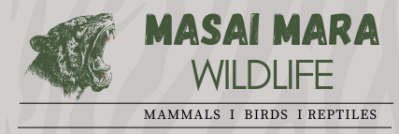- Common Names: Wild Dog, African Painted Dog
- Scientific Name: Lycaon pictus
- Swahili Name: Mbwa mwitu
- Maasai Name: Osuyani
- Size:
- Head-Body Length (HBT): 153 cm (60 inches)
- Shoulder Height (SH): 75 cm (30 inches)
- Gestation: 10 weeks
- Recognition: Wild Dogs are easily recognized by their slender, long-legged build and their strikingly mottled coat of black, tan, and white. Their large, rounded ears, bushy white-tipped tails, and expressive eyes make them one of Africa’s most visually distinctive predators.
Habits and Behavior
- Highly Sociable: Wild Dogs are incredibly social animals, living and hunting in packs that typically consist of 6 to 20 individuals. The pack is led by an alpha pair, and unlike many other carnivores, Wild Dogs exhibit strong social bonds. The entire pack participates in caring for pups, hunting, and ensuring the welfare of injured or weaker members.
- Pack Hunting and Success Rate: Wild Dogs are the most efficient hunters in Africa, with a remarkable success rate of 85% on their hunts, far surpassing lions, who manage only 30%. Their hunting technique involves endurance and teamwork, as they chase prey, often at speeds up to 64 kph (40 mph), until the target is exhausted. They target medium-sized antelope like Kirk’s Dik-dik and Impala, which they dismember rapidly using a coordinated pack attack.
- Incredible Coordination: During a hunt, Wild Dogs display exceptional cooperation. One dog may grab the tail of larger prey, another the face, while the rest of the pack disembowels the animal quickly and efficiently. Despite their brutal hunting methods, they are gentle and nurturing within the pack. Injured dogs or those too old to hunt are fed through regurgitation by their pack members, showcasing a strong social care system.
Social Structure
- Alpha Leadership: The pack is controlled by a dominant alpha pair, which holds exclusive breeding rights. These alphas lead the pack’s movements, hunts, and territory marking. All other members contribute by helping raise the pups, hunt, and protect their territory.
- Female Dispersal: Unlike males, which stay in the pack they are born into, females leave their natal pack after about two years to join other packs. This dispersal helps prevent inbreeding and ensures genetic diversity among the packs.
- Submission Over Aggression: Wild Dogs are notably non-aggressive within their social structure, with submission and cooperation being key traits. This has likely contributed to the overall health and efficiency of their packs.
Diet
- Feeds on: Wild Dogs primarily hunt medium-sized antelope such as Kirk’s Dik-dik and Impala. They also hunt hares, birds, and occasionally larger prey like Wildebeest calves. Their dietary flexibility and pack efficiency make them some of the most effective predators in the African savanna.
Habitat
- Where to Find: Wild Dogs are most often found in the savanna, acacia scrub, and woodland areas of the Masai Mara. However, they are extremely rare. Their pack ranges can cover over 2,000 km², and they often move between ecosystems, such as the Masai Mara and the Serengeti. These large home ranges help them adapt to seasonal changes in prey availability.
Conservation Status
- IUCN Status: Endangered. Once common across much of Africa, Wild Dogs have faced severe population declines due to habitat loss, human-wildlife conflict, and disease outbreaks such as canine distemper. They were nearly wiped out in the Serengeti-Mara ecosystem due to a canine distemper outbreak, but recent signs indicate a slow recovery. Current estimates suggest fewer than 6,000 individuals remain in the wild.
- Major Threats: The primary threats to Wild Dogs are human persecution, habitat fragmentation, and diseases spread from domestic dogs, such as rabies and distemper. In areas like the Masai Mara, they are also threatened by conflicts with herdsmen, who kill them to protect livestock.
Conservation Efforts
- Education and Compensation Programs: To reduce human-wildlife conflict, conservationists advocate for education programs to help local communities understand the ecological role of Wild Dogs. Compensation schemes for livestock losses can help reduce retaliatory killings.
- Vaccination Initiatives: Vaccination programs for domestic dogs living near wildlife reserves are critical in preventing the spread of diseases like canine distemper and rabies, which have devastated Wild Dog populations in the past.
Unique Traits
- Pack Efficiency: Wild Dogs are the most successful hunters among large African predators, with an 85% success rate in their hunts due to their endurance, coordination, and ability to chase prey to exhaustion.
- Social Care: These dogs are highly social, taking care of all members of the pack, including regurgitating food for those too old, injured, or young to hunt. This cooperation is rare among large predators.
- Wide Range and Movement: Wild Dogs cover immense territories, often moving between the Masai Mara and Serengeti. Their large home ranges help them adapt to the seasonal migration of prey animals.
Interesting Facts
- Unique Communication: Wild Dogs use a variety of vocalizations to communicate within the pack, from twittering calls to coordinate hunts to high-pitched yelps and whines used to greet one another or call pups.
- Victims of Disease: A major distemper outbreak nearly wiped out the Wild Dog population in the Serengeti-Mara ecosystem, though recent conservation efforts are showing promising signs of recovery.
In conclusion, the Wild Dog is one of the most fascinating and efficient predators in the Masai Mara. With a strong social structure, remarkable hunting abilities, and a dedicated effort to recover their dwindling numbers, these endangered canids are a testament to the resilience of wildlife when given the right support.
